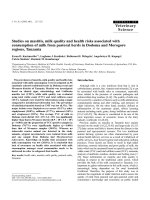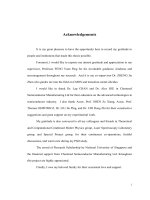Studies on genetic variability, heritability and genetic advance in F4 population of china aster [Callistephus chinensis L. (Nees.)]
Bạn đang xem bản rút gọn của tài liệu. Xem và tải ngay bản đầy đủ của tài liệu tại đây (236.98 KB, 6 trang )
Int.J.Curr.Microbiol.App.Sci (2019) 8(9): 822-828
International Journal of Current Microbiology and Applied Sciences
ISSN: 2319-7706 Volume 8 Number 09 (2019)
Journal homepage:
Original Research Article
/>
Studies on Genetic Variability, Heritability and Genetic Advance in F4
Population of China Aster [Callistephus chinensis L. (Nees.)]
Anita Hosalli*, Mukund Shiragur, B. C. Patil, Dileepkumar Masuthi, M. H. Tatager
Department of Floriculture and Landscape Architecture, University of Horticultural Sciences,
Bagalkot, Karnataka, India
*Corresponding author
ABSTRACT
Keywords
Genetic variability,
Heritability, F4
Population, China
Aster
Article Info
Accepted:
15 August 2019
Available Online:
10 September 2019
China aster (Callistephus chinensis L. (Nees.)) is a semi hardy annual and
commercial flower crop belonging to the family Asteraceae. China aster is
a self pollinated crop, but the natural outcrossing is approximately 10 per
cent as reported and described floral biology of China aster. The study
results revealed that high heritability along with high genetic advance
existed in cross viz., AAC-1 × Arka Poornima and Arka Kamini × P G
Purple for number of flowers per plant, individual flower weight and flower
yield per plant. Thus, these characters could be improved through simple
selection procedure due to the presence of additive type of gene action.
Introduction
The present day China aster had been
developed from single wild species.
According to Emsweller et al., (1937), the
original plant had single flower with two to
four rows of blue, violet or white ray florets.
The first change in the flower type was the
prolongation or development of central florets
and the production of quilled flowers.
Creation and utilization of variability using
proper breeding procedure is a pre-requisite
for the genetic improvement of any crop.
Generally, amount of variability generated is
more in the early segregating generations as
compared to later generations. The knowledge
of high estimate of heritability and genetic
advance as per cent mean assist the breeders to
decide and select superior plants, so that the
plants can perform superior for the traits of
interest in subsequent generation. Being a self
pollinated crop, there is need of high yielding
variety of China aster with specific colored
flowers to overcome farmer’s predicament.
Hence keeping all these in view, the present
study was undertaken to assess and estimate
the magnitude of variation among the F4
population with respect to various traits which
can be further utilized in crop improvement
programme.
823
Int.J.Curr.Microbiol.App.Sci (2019) 8(9): 822-828
Materials and Methods
The study was conducted during the year
2018-2019 at Department of Floriculture and
Landscape
Architecture,
Kittur
Rani
Channamma
Collage
of
Horticulture,
Arabhavi. The F4 population of two crosses
viz., AAC-1 × Arka Poornima and Arka
Kamini × P G Purple were selected based on
the superior yield and yield contributing
characters. The parent AAC-1 is locally
cultivated genotype with yield of 50 flowers
per plant and flower diameter of 6 cm; Arka
Poornima has flower yield per plant of 25
flowers and flower diameter of 5 cm; Arka
Kamini yields about 50 flowers with flower
diameter of 6 cm, and P G Purple released by
MPKV, Rahuri has yield of 42 flowers per
plant. One month old seedling were
transplanted into the main field with spacing
of 30×30cm. Observations were recorded for
the best 5 plants in each line for plant height
(cm), number of branches per plant, flower
stalk length (cm), flower diameter (cm), days
taken for flower bud initiation, days to 50
percent flowering, duration of flowering
(days), number of flowers per plant, individual
flower weight (g) and flower yield (g/plant).
The genotypic and phenotypic coefficient of
variation was estimated according to the
methods of Burton and De-Vane (1953).
Heritability in broad sense was calculated as
per method given by Johnson et al., (1955)
and Robinson et al., (1949). The expected
genetic advance as per cent of mean was
worked out as suggested by Johnson et al.,
(1955).
Results and Discussion
Among the two crosses, AAC-1 × Arka
Poornima cross was found to be significantly
superior for plant height, number of branches,
leaf area, flower diameter, stem girth, plant
spread in north -south and east-west direction,
shelf life (days), days taken for flower bud
initiation, number of flowers per plant,
individual flower weight and flower yield per
plant (Table 1). The cross Arka Kamini × P G
Purple recorded highest in flower stalk length.
Both crosses differed significantly for all traits
except for days to flower bud initiation,
duration of flowering, flower diameter and
individual flower weight.
The estimates of phenotypic coefficient of
variation (PCV) values were relatively higher
than those of genotypic coefficient of variation
(GCV) for all the traits (Table 1) which
indicated greater genotype x environment
interactions. The result is in accordance with
the report of Singh and Mishra (2006) High
phenotypic coefficient of variation (PCV) and
genotypic coefficient of variation (GCV) was
found for number of flowers per plant,
individual flower weight, flower yield(g) per
plant and for growth characters like number of
branches per plant and leaf area.(Karuppaiah
and Kumar, 2011 in marigold; Vikas et al.,
2011 in dahlia and Rajiv et al., 2014 in China
aster). There was less difference between PCV
and GCV indicating less influence of
environment on this trait (Suma and Patil,
2016 in daisy). Moderate PCV and GCV were
obtained for flower stalk length, plant height
and stem girth in both the crosses, AAC-1 ×
Arka Poornima and Arka Kamini × P G
Purple.
It indicated that selection would be difficult
for these characters, as the genotypic effect
would be modified by the environmental
effect. These results are in agreement with the
results of Jankiram and Rao (1991) in
marigold, Mishra et al., (2013) in
chrysanthemum and Rachappa (2014) in
China aster.
The crosses AAC-1 × Arka Poornima and
Arka Kamini × P G Purple showed almost
high heritability for all the traits shelf life in
AAC- 1 × Arka Poornima.
824
Int.J.Curr.Microbiol.App.Sci (2019) 8(9): 822-828
Table.1 Estimates of mean, range, components of variance, heritability and genetic advance for growth, quality and yield parameters
in F4 populations of two crosses in China aster
Sl.
No.
Character
1.
Plant height (cm)
2.
4.
5.
6.
7.
8.
9.
10.
11.
Number of branches
2
Leaf area (cm )
Stem girth (cm)
Plant spread (N-S)
(cm)
Plant spread (E-W)
(cm)
Days taken for
flower bud initiation
Days taken for
first flowering
Days taken for
50% flowering
Duration of flowering
(days)
Mean
Range
PCV
(%)
GCV
(%)
h2 (%)
GA
GAM
AAC-1 × Arka Poornima
50.51
40.00-62.00
13.22
11.48
75.43
10.38
20.55
Arka Kamini × P G Purple
47.85
30.25-60.30
20.40
20.35
90.00
17.35
37.82
AAC-1 × Arka Poornima
14.75
12.00-20.00
27.49
11.66
44.43
2.36
16.01
Arka Kamini × P G Purple
8.07
6.00-10.50
28.05
25.53
74.06
2.22
27.53
AAC-1 × Arka Poornima
2072.21
1233.49- 3235.76
31.30
27.93
79.66
1064.34
51.36
Arka Kamini × P G Purple
1786.33
1069.54- 2592.17
25.60
23.57
72.22
762.34
42.67
AAC-1 × Arka Poornima
1.47
1.28-1.68
9.07
5.83
41.33
0.11
7.72
Arka Kamini × P G Purple
1.34
1.07-1.87
14.10
12.43
83.50
0.35
26.55
AAC-1 × Arka Poornima
35.46
25.76-45.32
18.91
16.47
75.91
10.48
29.57
Arka Kamini × P G Purple
28.63
19.65-51.40
31.14
30.31
94.74
17.40
60.79
AAC-1 × Arka Poornima
32.02
23.95-50.96
21.82
17.82
66.70
9.60
29.98
Arka Kamini × P G Purple
30.74
29.51-41.35
25.60
23.11
81.47
13.21
42.97
AAC-1 × Arka poornima
52.09
47.90 -56.70
6.62
5.11
59.68
4.24
8.14
Arka Kamini × P G Purple
44.92
40.80 – 52.47
7.83
6.20
62.69
4.54
10.11
AAC-1 × Arka poornima
61.42
57.10 – 66.50
5.84
4.95
71.97
5.32
8.66
Arka Kamini × P G Purple
56.40
51.38 - 65.07
7.96
6.07
58.33
5.3
9.5
AAC-1 ×Arka poornima
75.10
70.50 – 80.50
4.48
3.37
56.64
3.93
5.23
Arka Kamini × P G Purple
72.16
64.00 –82.00
5.20
4.52
75.68
5.91
8.11
AAC-1 × Arka poornima
35.26
31.50 - 40.65
7.84
5.43
47.94
2.73
7.74
Arka Kamini × P G Purple
36.52
29.82-42.42
9.29
10.99
71.55
5.91
16.20
F4 population
825
Int.J.Curr.Microbiol.App.Sci (2019) 8(9): 822-828
12.
Flower
(cm)
stalk
length
13.
Flower diameter (cm)
14.
Shelf life (days)
15.
16.
17.
18.
Number of flowers per plant
Individual flower weight (g)
Flower yield (g/plant)
Flower yield (t/ha)
19.
Seed yield/plant (g)
20.
Seed test weight (g)
AAC-1 × Arka poornima
21.17
14.75-27.50
18.41
12.00
82.50
3.41
26.11
Arka Kamini × P G Purple
22.06
16.48 – 29.87
21.71
19.99
84.83
8.37
37.93
AAC-1 × Arka poornima
5.30
4.03- 6.08
12.07
7.75
41.22
0.54
10.24
Arka Kamini × P G Purple
4.99
3.15-6.00
13.44
10.23
82.74
1.14
22.92
AAC-1 × Arka poornima
2.45
2.50-4.50
8.65
5.33
37.00
0.50
6.77
Arka Kamini × P G Purple
2.27
2.00-.400
9.62
7.26
56.87
0.86
11.27
AAC-1 × Arka Poornima
40.62
23.00-.59.00
30.09
29.31
94.87
19.83
58.81
Arka Kamini × P G Purple
28.12
18.35- 42.20
24.06
22.56
87.87
12.25
43.57
AAC-1 × Arka Poornima
3.47
2.04- 5.85
30.31
29.73
96.20
1.54
60.06
Arka Kamini × P G Purple
2.87
1.4 - 4.70
29.16
28.47
95.38
1.64
57.29
AAC-1 × Arka Poornima
114.59
35.65- 225.60
40.10
39.18
95.46
84.85
78.86
Arka Kamini × P G Purple
78.73
31.98- 120.48
32.83
31.57
92.47
49.25
62.55
AAC-1 × Arka Poornima
3.46
2.11 – 5.23
23.05
20.45
78.71
1.29
37.38
Arka Kamini × P G Purple
2.84
2.10 – 6.65
23.38
17.64
56.92
0.78
27.42
AAC-1 × Arka Poornima
3.15
2.80 – 2.69
19.64
19.14
98.70
1.46
39.85
1.06
39.06
Arka Kamini × P G Purple
2.73
2.15 – 4.10
20.71
19.82
91.55
AAC-1 × Arka Poornima
2.15
1.80 – 2.69
9.68
7.83
65.43
0.28
13.05
Arka Kamini × P G Purple
2.08
1.87 – 2.60
9.94
5.45
30.00
0.13
6.15
826
Int.J.Curr.Microbiol.App.Sci (2019) 8(9): 822-828
These findings suggest the scope for
improvement of the character through direct
selection. The results of the present study
were supported by those of Vikas et al.,
(2011) and Rachappa (2014) for flower stalk
length, flower diameter, ray floret length and
disc diameter in China aster. Karuppaiah and
Kumar (2011) in marigold recorded high
heritability for number of flowers per plant,
individual flower weight and flower yield per
plant. Anuja and Jahnavi (2012) reported
similar results in marigold for plant height,
number of branches and number of leaves.
Heritability along with genetic advance
increases the efficiency of selection in a
breeding programme by assessing the
influence of environmental factors and
additive gene action. In both the crosses high
heritability along with high genetic advance
as per cent mean for number of flowers per
plant, individual flower weight and flower
yield per plant and vase life. These results are
in line with the findings of Karuppaiah and
Kumar (2011) in marigold and Rajiv et al.,
(2014) in China aster for stalk length, flower
diameter, disc diameter, number of flowers
per plant, individual flower weight and flower
yield per plant. The cross Arka Kamini × P G
Purple recorded high heritability along with
high genetic advance for plant height and
stem girth. similar results are in accordance
with the finding of Rachappa (2014).This
revealed that the characters are governed by
the additive type of action and these
characters are useful for phenotypic selection.
References
Anuja S and Jahnavi K 2012. Variability,
heritability and genetic advance studies
in French marigold (Tagetes patula L.)
Asian J Hort 7(2): 362-64.
Burton G W and De-Vane E H 1953.
Estimating heritability in tall fescue
(Festuca
arundinaceaei)
from
replicated clonal material. Agron J 45
(10): 284-91.
Emsweller S L, Brierley P, Lumsden D V and
Mulferd F L 1937. Breeding of
ornamental plants. U. S. D. A. Year
book of Agriculture, U. S. Department
of Agriculture, pp. 926-29.
Fleming, W M 1937. U. S. D. A. Year book of
Agriculture, U. S.Department of
Agriculture, 985p.
Janakiram T and Rao T M 1991. Genetic
improvement
of
marigold.
In:
Floriculture Technology, Trade and
Trends. Prakash, J and Bhandary, K R
(eds.), Oxford and IBH Company Pvt.
Ltd., New , pp 331-35.
Johnson H W, Robinson H F and Constock R
E 1955. Estimate of genetic and
environmental variability in Soyabeans.
Apron J 47: 314-18.
Karuppaiah P and Kumar P S 2011.
Correlation and path analysis in African
marigold (Tagetes erecta L.). Electronic
J Plant Br 1(2): 217-20.
Kavitha R and Anburani A 2010. Genetic
variability in African marigold (Tagetes
erecta L.). Asian J Hort 5(2): 344-46.
Mishra H N, Das J N and Palai S K 2006.
Genetic variability studies in spray type
chrysanthemum. Orissa J Hort 34(1): 812.
Rachappa K K 2014. Studies on genetic
variability
and
molecular
characterization in China aster
(Callistephus chinensis [L.] Nees.). M.
Sc., Thesis, University of Horticultural
Sciences, Bagalkot. India.
The study results revealed that high
heritability along with high genetic advance
existed in cross viz., AAC-1 × Arka Poornima
and Arka Kamini × P G Purple for number of
flowers per plant, individual flower weight
and flower yield per plant. Thus, these
characters could be improved through simple
selection procedure due to the presence of
additive type of gene action.
827
Int.J.Curr.Microbiol.App.Sci (2019) 8(9): 822-828
Rajiv K, Gayatri K, Manjunatha R T and
Dhananjaya M V 2014. Genetic
variability for quantitative traits in
China aster. Agro Technol 2(4): 105-10.
Robinson H F, Comstock R E and Harvey P
H 1949. Estimates of heritability and
the degree of dominance in corn. Agron
J 41(8): 353–59.
Senapati A K, Priyanka P and Alka S 2013.
Genetic variability and heritability
studies in Gerbera jamesonii Bolus. Afr
J Agric Res 8(41): 5090-92.
Sharma B P and Raghuvanshi A 2011.
Genetic variability and correlation
studies in French marigold. Prog Agric
11(1): 54- 57.
Singh D and Mishra K K 2008. Genetic
variability in quantitative characters of
marigold. Indian J Hort 65(2): 187-92.
Strube H 1965. New ertenntnisse and
erfahrungen in der astern suchtung I and
II (New knowledge and results in aster
breeding I and II). Dtsche Getenb 12:
134-66.
Suma V and Patil V S 2006. Genetic
variability and character association
studies in Daisy (Aster amellus L.)
genotypes. Karnataka J Agric Sci 19(3):
749-53.
Vikas H M, Patil V S Agasimani, A D and
Praveenkumar D A 2011. Studies on
genetic variability in Dahlia (Dahlia
variabis) J S N 2(2): 372-75.
How to cite this article:
Anita Hosalli, Mukund Shiragur, B. C. Patil, Dileepkumar Masuthi, Tatager, M. H. 2019.
Studies on Genetic Variability, Heritability and Genetic Advance in F4 Population of China
Aster [Callistephus chinensis L. (Nees.)]. Int.J.Curr.Microbiol.App.Sci. 8(09): 822-828.
doi: />
828
![Chemical and functional components in different parts of rough rice (oryza sativa l[1] ) beforeandaftergermination](https://media.store123doc.com/images/document/14/rc/qa/medium_qab1394872940.jpg)








